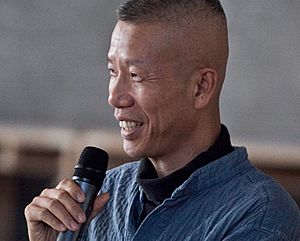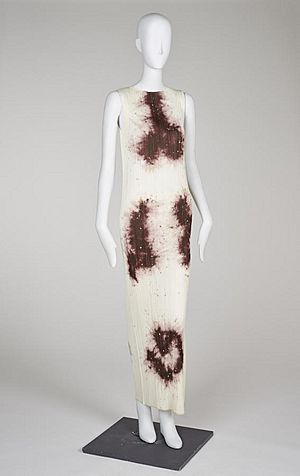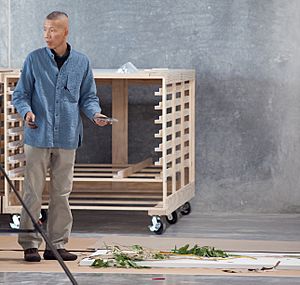Cai Guo-Qiang facts for kids
Quick facts for kids
Cai Guo-Qiang
|
|
|---|---|

Cai in October 2010
|
|
| Born | December 8, 1957 |
| Nationality | Chinese |
| Education | Shanghai Theatre Academy |
| Movement | Contemporary art |
| Awards |
|
| Cai Guo-Qiang | |||||||||||||
|---|---|---|---|---|---|---|---|---|---|---|---|---|---|
| Traditional Chinese | 蔡國強 | ||||||||||||
| Simplified Chinese | 蔡国强 | ||||||||||||
|
|||||||||||||
Cai Guo-Qiang (Chinese: 蔡国强; born December 8, 1957) is a famous Chinese artist. He is known for his amazing art, especially his large-scale projects using gunpowder and fireworks.
Contents
About Cai Guo-Qiang
Cai Guo-Qiang was born in 1957 in Quanzhou, a city in Fujian Province, China. His father, Cai Ruiqin, was a calligrapher and traditional painter. This meant Cai grew up around both Chinese art and Western books.
As a young person, Cai saw many big changes happening in China. He also grew up in a place where explosions were common. These could be from cannons or from fireworks used for celebrations. He learned that gunpowder could be used for both destruction and creation.
In his late teens, Cai acted in two martial arts movies. Later, he became interested in Western art like oil painting. He studied stage design at the Shanghai Theater Academy from 1981 to 1985. This helped him learn about theater, how to arrange things in a space, and how to work with others.
Cai's Amazing Art
Cai Guo-Qiang uses many different ideas and materials in his art. These include traditional Chinese ideas like fengshui and Chinese medicine. He also uses things from nature, science, and even portraits. Many of his works are inspired by Chinese culture and history.
Early Artworks
Cai's early art was inspired by traditional Chinese culture and political topics. As a student, he made drawings using oil paints and burnt gunpowder. He moved to Japan in 1986, where he continued to develop his unique style.
Projects for Extraterrestrials
In 1990, Cai started a series called Projects for Extraterrestrials. For these projects, he used huge fireworks and long trails of burning gunpowder. These trails would stretch across landscapes and buildings. They were made in different places all over the world.
One famous project was Project to Extend the Great Wall of China by 10,000 Meters (1993). This involved a six-mile-long gunpowder fuse that went beyond the Great Wall of China. When lit, it burned for about 15 minutes. It created a dragon-like pattern across the desert. Cai wanted these projects to show pure energy and joy, using gunpowder in a new way.
Gunpowder Art
Cai started exploring how gunpowder could be used in his drawings in 1995. This led him to create huge "explosion events." In 1995, he moved to New York. He received a grant from the Asian Cultural Council to help artists from Asia and the United States share ideas.
In 1998, Cai worked with fashion designer Issey Miyake. Cai arranged gunpowder on white clothes to make dragon shapes. He then set fire to the powder, burning the images into the fabric. These designs were later used for Miyake's clothing line.
Inopportune Artworks
In 2004, Cai Guo-Qiang created Inopportune: Stage One and Inopportune: Stage Two. These were shown at the Massachusetts Museum of Contemporary Art (MASS MoCA). The artworks were also shown at the Guggenheim Museum in New York in 2008.
Inopportune: Stage One showed nine cars. They looked like they were tumbling through the air in slow motion. Long, clear rods with colorful lights came out of the cars. It looked like an explosion frozen in time.
In Inopportune: Stage 2, nine realistic tigers floated in the air. Each tiger had many arrows sticking out of it. This artwork was inspired by an old Chinese story about a brave man who saved a village from a tiger. These artworks made people think about big ideas like bravery and beauty. Inopportune: Stage One can also be seen at the Seattle Art Museum.
2008 Beijing Summer Olympics
Cai was asked to create art for the 2008 Beijing Summer Olympics. He was the director of visual and special effects for the opening and closing ceremonies. He designed amazing fireworks shows, including the "Footprints of History" fireworks for the opening ceremony.
City of Flowers in the Sky
On November 18, 2018, Cai Guo-Qiang created a beautiful fireworks display in Florence, Italy. He used the sky as his canvas to make explosive flowers. The show lasted about ten minutes over Piazzale Michelangelo. It was inspired by Botticelli's famous painting "Primavera." About 50,000 special fireworks released smoke that looked like thousands of flowers. This event introduced Cai's art show at the Uffizi museum.
WE ARE: Explosion Event for PST ART
On September 15, 2024, Cai Guo-Qiang created a daytime fireworks event called “WE ARE: Explosion Event for PST ART.” This happened at the Los Angeles Memorial Coliseum. It was the start of a big art festival. Cai designed this show with his own special AI model, cAI™. This model uses information from his past artworks and ideas.
This event was the first time in U.S. history that over one thousand aerial drones carried fireworks. About 4,000 to 4,500 guests watched the fiery and smoky show. It caused loud blasts around the stadium and the nearby USC campus.
Other Artworks
In 2016, Cai's work was featured in a Netflix documentary called Sky Ladder: The Art of Cai Guo-Qiang. This film showed his work with fireworks, especially his amazing 1,650-foot ladder made of gunpowder.
Cai also created Odyssey, a permanent gunpowder drawing for the Museum of Fine Arts, Houston, in 2010. It is one of his largest gunpowder drawings. In 2011, his exhibition Cai Guo-Qiang: Saraab opened in Doha, Qatar. It was his first solo show in the Middle East.
In 2012, Cai’s “Mystery Circle: Explosion Event” featured 40,000 mini rockets. They blasted for about two minutes at the Museum of Contemporary Art (MOCA) in Los Angeles.
Awards and Recognition
Cai Guo-Qiang has won many important awards for his art. He won the Golden Lion at the 48th Venice Biennale in 1999. He also received the Alpert Awards in the Arts in 2001 and the Fukuoka Asian Culture Prize in 2009.
In 2008, a big exhibition of his work called I Want To Believe was shown at the Solomon R. Guggenheim Museum in New York. It later traveled to China and Spain. In October 2012, he received the Praemium Imperiale in Tokyo. This is a very important award for artists. In May 2022, he received the John D. Rockefeller III Award. This award is given to people who help connect Asian and U.S. arts.
Cai's Personal Life
Cai moved from Beijing to New York in 1995. He still has a home in Beijing. In the mid-2010s, he made his gunpowder paintings at a fireworks factory in New York. His studio in Manhattan was designed by a famous architect, Rem Koolhaas. Cai hopes it will become a foundation where people can see his work. He wanted a place where he could live and work with his family.
In 2011, Cai bought a former horse farm in New Jersey. This property was redesigned by another famous architect, Frank Gehry. The barn was turned into a huge studio, and the stables became archives for his work. The house itself is built with glass and wood. Cai lives there with his wife and two daughters.
Selected Art Shows and Projects
- Flora Commedia: Cai Guo-Qiang at the Uffizi, City of Florence, November 2018-February 2019
- Cai Guo Qiang: A Clan of Boats, Faurschou Foundation, Copenhagen, Denmark, 2012
- Cai Guo-Qiang: Sky Ladder, Museum of Contemporary Art, Los Angeles, California, 2012
- Cai Guo-Qiang: Saraab, Mathaf: Arab Museum of Modern Art, Doha, Qatar, 2011
- Cai Guo-Qiang: Resplandor y Soledad. Museo Universitario de Arte Contemporáneo (MUAC), Ciudad Universitaria, Universidad Nacional Autónoma de México (UNAM). 2011
- Cai Guo-Qiang : fallen blossoms, Philadelphia Museum of Art, Philadelphia, Pennsylvania, 2010
- Cai Guo-Qiang: Hanging Out in the Museum , Taipei Fine Arts Museum, Taipei, 2009
- Cai Guo-Qiang: I Want to Believe, Solomon R. Guggenheim Museum, New York City, 2008; Guggenheim Museum Bilbao, 2009
- Inopportune: Stage One and Illusion, Seattle Art Museum, Seattle, 2007
- Cai Guo-Qiang on the Roof: Transparent Monument, Metropolitan Museum of Art Roof Garden, New York City, 2006
- Arte all'Arte, Colle di Val d'Elsa, 2005
- Curated the first China Pavilion at the 51st Venice Biennale, 2005
- Tornado: Explosion Project for the Festival of China, Kennedy Center for the Performing Arts, 2005; Washington, D.C., 2005.
- Cai Guo-Qiang: Inopportune, Mass MoCA, North Adams, Massachusetts, 2005
- Cai Guo-Qiang: Traveler, Freer Gallery of Art and Arthur M. Sackler Gallery, and Hirshhorn Museum and Sculpture Garden at the Smithsonian Institution, Washington, D.C., 2004
- Organizing and curating BMoCA: Bunker Museum of Contemporary Art, Kinmen, Taiwan, 2004
- Light Cycle: Explosion Project for Central Park, New York, 2003
- Ye Gong Hao Long: Explosion Project for Tate Modern, Tate Modern, London, 2003
- Transient Rainbow, Museum of Modern Art, New York, 2002;
- Cai Guo-Qiang, Shanghai Art Museum, Shanghai, 2002
- APEC Cityscape Fireworks Show, Asia Pacific Economic Cooperation, Shanghai, 2001
- Cai Guo-Qiang: An Arbitrary History, Musee d'art Contemporain Lyon, France, 2001
- Cai Guo-Qiang, Fondation Cartier pour l'art contemporain, Paris, 2000
- Cultural Melting Bath: Projects for the 20th Century, Queens Museum of Art, Queens, New York, 1997
- Flying Dragon in the Heavens, Louisiana Museum of Modern Art, Humblebaek, Denmark, 1997
- The Century with Mushroom Clouds: Project for the 20th Century, New York, 1996
- The Earth Has Its Black Hole Too, Hiroshima, Japan, 1994
- Project to Extend the Great Wall of China by 10,000 Meters, Jiayuguan City, China, 1993.
See also
 In Spanish: Cai Guo-Qiang para niños
In Spanish: Cai Guo-Qiang para niños




